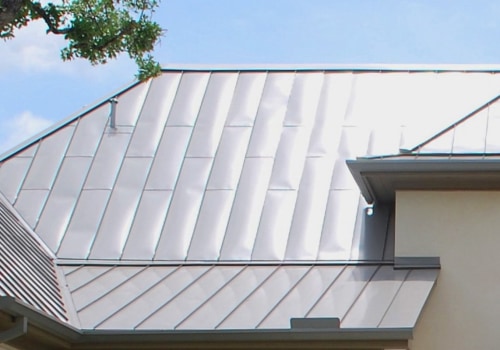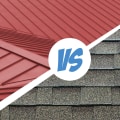Metal roofs have been gaining popularity in recent years due to their durability, energy efficiency, and long lifespan. Despite these benefits, metal roofs are still not as commonly seen on residential homes as asphalt shingles or other roofing materials. Many homeowners are curious why metal roofing hasn’t become the standard, given its reputation for weather resistance and low maintenance. There are several factors that explain why more houses don’t have metal roofs, including cost, aesthetic preferences, and concerns about installation complexity. This article will delve into these reasons and help you understand the pros and cons of metal roofing.
Cost: The Biggest Barrier to Metal Roof Adoption
One of the most significant reasons more houses don’t have metal roofs is the upfront cost. Metal roofs are generally more expensive than traditional asphalt shingles, which are the most common roofing material in the United States. The price difference can be substantial, with metal roofing often costing two to three times more than asphalt shingles, depending on the type of metal used.
For homeowners on a budget, the higher cost of materials and labor makes metal roofing less appealing. While metal roofs offer a longer lifespan—typically lasting 50 years or more compared to 20 to 30 years for asphalt shingles—the initial investment can be prohibitive for many. This is especially true for homeowners who may not plan to stay in their home long enough to recoup the long-term savings that metal roofing provides through reduced maintenance and energy efficiency.
In many cases, homeowners prioritize short-term savings over long-term benefits, leading them to choose more affordable options like asphalt shingles. This preference for lower upfront costs is a major reason why more houses don’t feature metal roofing, even though it could save homeowners money over time.
Aesthetic Preferences: The Traditional Look of Asphalt Shingles
Another reason metal roofs aren’t as common on residential homes is aesthetic preferences. Many homeowners prefer the traditional appearance of asphalt shingles, which offer a wide range of colors and textures to suit different architectural styles. Asphalt shingles are often seen as more visually appealing for suburban homes, contributing to their widespread use.
In contrast, metal roofing—particularly standing seam panels or corrugated metal—can have a more industrial or commercial look. While metal roofing manufacturers now offer a variety of styles and colors, including metal shingles that mimic the appearance of slate, tile, or wood, some homeowners still perceive metal roofing as less attractive for residential properties.
Additionally, homeowners' associations (HOAs) and local building codes in certain neighborhoods may have aesthetic regulations that discourage or prohibit the use of metal roofing. These regulations are often aimed at maintaining uniformity in the appearance of homes, which can limit homeowners' choices, particularly in traditional or historic neighborhoods. As a result, metal roofs are less commonly seen on homes, even in areas where their weather resistance would be beneficial.
Installation Complexity and Labor Costs
The complexity of installing a metal roof is another reason more houses don’t have them. Installing a metal roof requires specialized skills, equipment, and precision that may not be as readily available as the expertise needed for asphalt shingles. Metal roofs must be installed carefully to ensure proper alignment, secure fastening, and effective sealing to prevent leaks. This requires contractors who are experienced in working with metal roofing materials, and such specialists may not be as easy to find in some areas.
Furthermore, the installation process can take longer for metal roofing compared to asphalt shingles. For example, metal panels or shingles must be custom-cut to fit the specific dimensions of a roof, which can increase labor time and costs. This makes metal roofing installations more expensive, not only because of the cost of materials but also due to the higher labor costs associated with the more complex installation process.
In areas where labor for specialized metal roofing installations is in short supply, homeowners may be hesitant to choose this option, especially if it requires importing contractors from out of town. These factors contribute to the lower adoption of metal roofing, particularly in regions where asphalt shingle installation is more common and cost-effective.
Noise and Other Concerns
Some homeowners also avoid metal roofs because of concerns about noise during rain or hail. While modern metal roofing systems typically include insulation that minimizes noise, the perception of metal roofs as being loud persists. This misconception, combined with concerns about potential dents from hail, deters some homeowners from choosing metal roofing.
Additionally, there are myths about metal roofs being more susceptible to lightning strikes. While metal roofs do conduct electricity, they do not attract lightning more than other materials, and they actually provide a safer roofing option because metal is non-combustible. Despite the safety and performance benefits, these misconceptions continue to affect homeowners’ decisions.
Conclusion: Why Metal Roofs Aren’t More Common
While metal roofing offers numerous advantages, including durability, energy efficiency, and longevity, several factors explain why it isn’t more commonly seen on residential homes. The higher upfront cost, aesthetic preferences, and the complexity of installation all contribute to the relatively low adoption rate. Additionally, concerns about noise and other misconceptions about metal roofs further dissuade homeowners from choosing this material.
Ultimately, homeowners must weigh the long-term benefits of a metal roof against the higher initial cost and the potential challenges associated with installation. Roofing Brooklyn, for example, offers a wide range of roofing options and can help homeowners determine whether metal roofing is the right choice for their specific needs. While metal roofs may not be as common as asphalt shingles, they remain an excellent option for those who prioritize durability and long-term savings. As more homeowners recognize these benefits, metal roofing may become a more popular choice in the future.







